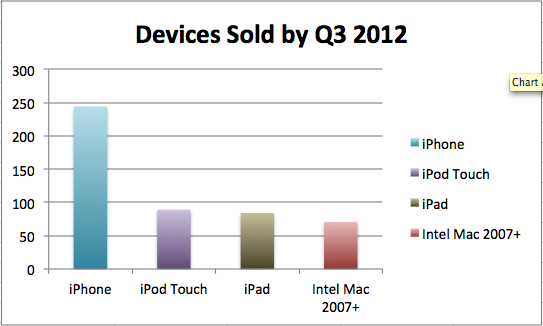This is an update to the last sales statistics post to include Apple’s Q2 and Q3 2012 results as well as adding Macintosh sales:
I got the Mac sales numbers from Apple’s quarterly Earnings Press Releases dating back to Q1/2007. Nearly all Macs sold from 2007 onwards are capable of running at least OS X 10.7 (Lion). The Mac numbers include both desktop (iMac, Mac mini, Mac Pro) and portable (MacBook series) machines.
This puts things in perspective from sheer numbers. There are now more iPads in the world than there are (relatively up-to-date) Macs!
On the other hand, given that most Macs cost over $1,000 the sales numbers aren’t reflecting revenue. But you can argue that making a Mac OS X (Mountain) Lion app has the potential to reach the same number of App Store users than an iPad exclusive app.
This continues and concludes the previous post of the Fast Pixel-Perfect Collision Detection for Cocos2D with Example Code (1/2) article.
Detecting collisions on pixel-perfect boundaries is the holy grail of collision detection in 2D games. As such, it seems like the ideal, if not to say perfect, solution to collision detection in general. Yet, it’s also quite complicated and the straightforward solutions don’t perform very well until you start optimizing the code.
This first post focuses on creating a pixel mask by analyzing the raw image data, as proposed over 3 years ago by Ernesto Corvi. It’s the fastest solution if you want to test if a point collides with a pixel on an image, which also works for rotated and scaled sprites. However it does take some optimizing to speed up detecting collisions between a bounding box of a node and the pixel mask, or two pixel masks.
The alternative solution is to render the two colliding objects onto a CCRenderTexture, as developed by Dani and others on the Cocos2D forum. It is able to detect collisions of arbitrarily rotated and scaled sprites but can be expected to be noticeably slower than a pixel mask. I will discuss this solution in a future iDevBlogADay post.
The results will find their way into Kobold2D, to make the solutions readily available to all developers.
Scheduled for release on November 7th, 2011. Continue reading »












